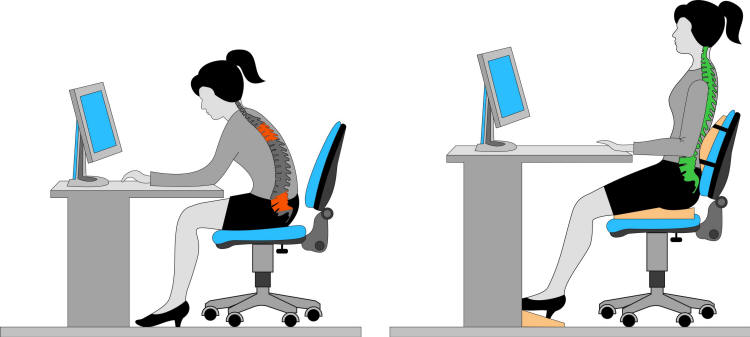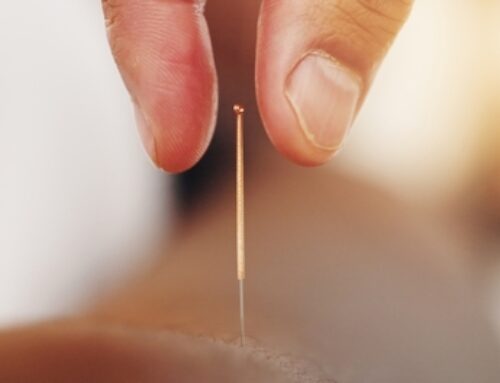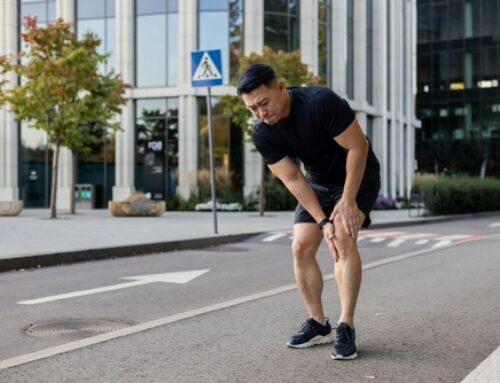Sitting is the New Smoking
“Sitting is the new smoking” is a catch phrase that is presently circulating rehab and chiropractic circles. As a practitioner who specializes in curing injuries that are caused by repetitive movements and prolonged bad posture, I can assure you that sitting can be just as dangerous as smoking. Sitting at a desk for extended periods of time, for example, creates many unintended health problems and can greatly reduce your quality of life.
The Dangers of Poor Posture
According to Stuart McGill’s book, “Ultimate Back Fitness and Performance,” poor sitting posture, (i.e. sitting with a rounded lower back, forward head position,) combined with constantly looking downward, places heavy strain on the ligaments of your spine and the discs between your vertebrae in your neck and lower back.
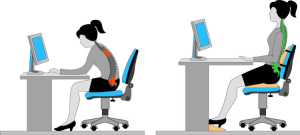 An excessively rounded back can become weakened and result in intervertebral discs bulging and placing pressure on the nerves of the spine. This can cause radiating pain down your arms, buttocks, and legs. In addition, poor seated posture encourages your abdominals to bow outward creating a rounded abdomen, which may result in weakened abdominal muscles, which may lead to an increased risk of lower back injury.
An excessively rounded back can become weakened and result in intervertebral discs bulging and placing pressure on the nerves of the spine. This can cause radiating pain down your arms, buttocks, and legs. In addition, poor seated posture encourages your abdominals to bow outward creating a rounded abdomen, which may result in weakened abdominal muscles, which may lead to an increased risk of lower back injury.
Benefits of Improved Posture
Good seated posture reduces back and neck strain. Lifting the chest and decompressing the abdomen leads to easier and deeper breathing as well as better digestion. Good posture also uses less energy than bad posture, as your head is essentially balanced directly over your spine as opposed to relying on muscles for support. This reduces the amount of energy you expend when working at your desk; which will result in greater comfort and increased productivity.
Perfect Computer Posture
- Most importantly, get the weight off your shoulders. The longer you hold your elbows away from your body, the stiffer your neck and shoulder muscles will become. The solution is easy: Use arm rests when you type and manipulate a computer mouse. Support your elbows at a comfortable height. If you lack armrests, use a wrist-supporting keyboard.
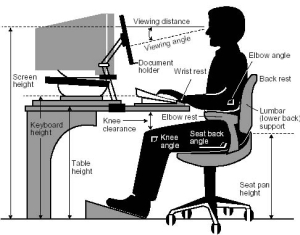 Use a keyboard tray that pulls out from under the desktop. A desk could be too high for a keyboard. If it is too high, you have to hold your elbows out again causing shoulder muscle strain.
Use a keyboard tray that pulls out from under the desktop. A desk could be too high for a keyboard. If it is too high, you have to hold your elbows out again causing shoulder muscle strain.- Use a chair with lumbar support, to help you sit up properly. Slouching will eventually strain your neck as you jut your jaw out to see the screen.
- Get your mouse in front of you as much as you can. Rotating your arm out to the side is hard on the rotator cuff muscles. Eventually, they’ll get stiff and become prone to injury with reaching and overhead movements.
- Monitors should be directly in front of you to diminish stress with rotation of the neck. More importantly, place your monitor at the correct height. The monitor should be at eye level. Preferably, keep your monitor higher than eye level to keep the cervical spine in its proper curvature.
Alternative Ergonomic Suggestions
Although there is abundant research regarding the effects of gym balls on exercise fitness, there is a clear lack of findings when it comes to utilizing exercise balls as an alternative to the traditional chair. Four studies performed by Stuart McGill, the renowned spine researcher, found that sitting on an exercise ball does not significantly affect magnitude of muscle activation, spine posture, spine loads, or overall spine stability. Two other studies found that sitting on a gym ball did nothing to alter the poor posture it was supposed to correct. This leads to the conclusion that any advantages of sitting on a gym ball may not outweigh the disadvantages noted in this study.
Although the limited research is against the use of gym balls, many patients may still opt to use a gym ball or other optional workstation. Standing desks are becoming increasingly popular. Low-cost desktop solutions are becoming commonplace now in many offices and employees are finding them very useful.
Take-Home Points
- Change Is Good: This is the ideal posture shown in many ergonomic texts.
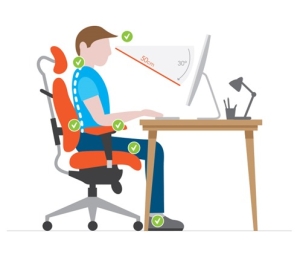 This may be the ideal sitting posture, but for no longer than 10 minutes! Tissue loads must be changed from tissue to tissue to minimize the risk of any single tissue accumulating micro trauma. This is accomplished by changing posture. Thus, the perfect ergonomic setup is one that facilitates easy posture changes over a variety of joint angles. Researchers have documented that using three to four different spine positions and postures help people avoid fatigue the best.
This may be the ideal sitting posture, but for no longer than 10 minutes! Tissue loads must be changed from tissue to tissue to minimize the risk of any single tissue accumulating micro trauma. This is accomplished by changing posture. Thus, the perfect ergonomic setup is one that facilitates easy posture changes over a variety of joint angles. Researchers have documented that using three to four different spine positions and postures help people avoid fatigue the best. - The primary recommendation is to continually change your positioning at work. Many workers continue to believe that there is a single best posture for sitting and are reluctant to try others. This is, of course, unfortunate, as the ideal sitting posture is a variable one. Many employees need to be educated as to how to change their chairs and the variety of postures that are possible.
- Get out of the chair. There simply is no substitute for getting out of the chair. Some guidelines suggest performing exercise breaks while seated, and some even go as far as to suggest flexing the torso in a stretch. This is both nonsense and disastrous! A rest break must consist of the opposite activity to reduce the imposed stressors. Extension relieves posterior annulus stress, but more flexion while seated increases it. The recommended break that we have developed involves standing from the chair and maintaining a relaxed standing posture for 10 to 20 seconds. At this stage, some may choose to perform neck rolls and arm windmills to relieve neck and shoulder discomfort from working at the desk. The main objective is to perhaps avoid annular stress. The individual continues by raising the arms over the head and then pushing the hands upward to the ceiling. By inhaling deeply, one will find that the low back is fully extended. In this way, the individual has taken the back through gentle and progressive lumbar extension without having been taught the concept of lumbar position awareness. Some will argue that, in their jobs, they cannot stand and take a break; they must continue their seated work. Many people will need to be shown how to create opportunities for standing. For example, they could choose to stand when the phone rings and continue standing for the length of the conversation. With simple examples like this one, they will soon see the opportunities to practice this part of good spine health.
- Perform an exercise routine at some point during the workday. Midday would be ideal, but several times per day may be best. (See the previous guideline.) Two good exercise routines can be seen on our video page HERE.
Be sure to check out the Biofreeze sale in the office this week: 10% off!
If you have questions, please call our Roanoke, Virginia chiropractic office at 1-540-344-1055.
Dr. Daryl Rich, DC, CSCS

